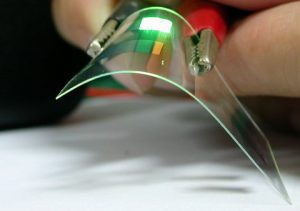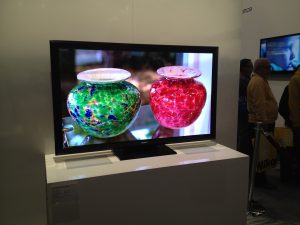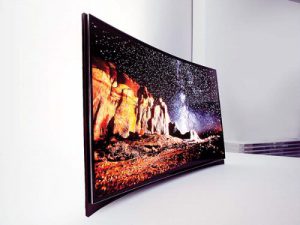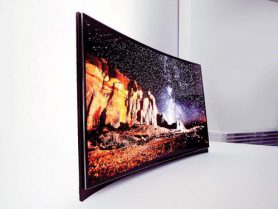
For those of you who aren’t me, you probably don’t pay a whole lot of attention to the Consumer Electronics Show (CES) held annually every January.
The CES is basically THE expo for all tech companies to demo their latest and greatest trying to begin lubricating the wallets of the gadget-friendly people out there (me). Year after year, new things come and go. Some never make it to mass consumption, some do but dont make a big splash, and sometimes something comes along that changes the way that we interact with electronics.
This year, the biggest buzz was around new ‘4K’ or Ultra High Definition Televisions. Oooh, theyre not high definition, they’re ULTRA high definition.
Another lesser hyped technology in future televisions are OLED televisions. Don’t you love acronyms? You might think, “well, I already have an LED television, do I really need that extra ‘O’?”
Well, as with both technologies, there’s an easy way and a very complicated way to explain the difference. I’ll try to find some kind of middle ground and give you my two cents.
4K aka Ultra High Definition (UHD)
Most current High Definition (HD) televisions have a resolution of 1920×1080 pixels. A pixel is a tiny dot on your television screen made up of red, green, and blue tinier dots. As you all should remember from grade school science class, red, green, and blue are the
![]()
primary colors of light. With just those three, you can blend them to make any visible color, even white. ut enough pixels together, and you get a grid of pixels. Connect that grid to some type of central computer CPU that can change the color of each pixel and do that in a predictable pattern, and you have yourselves a television.
So, current HDTVs have a grand total of 1,920 pixels from side to side and 1080 from top to bottom. UHD TVs have double that in both directions. So they have 3,840 pixels from side to side and 2,160 from top to bottom. For the companies like Sony, who insist on confusing comsumers and calling these TVs 4K instead of UHD like everyone else, the 4K comes from rounding up the horizontal resolution of 3,840 pixels to 4,000 pixels, hence the 4K. Get it?
So, you’re probably wondering, more pixels means a better picture right? Well yes….and no. Huh?
At this point, I have to draw a line of how detailed I go into why UHD isnt going to look any better than plain old “regular” HD. Rather than repeat information that is widely available on the internet, I recommend you read the following article from CNET:
http://reviews.cnet.com/8301-33199_7-57366319-221/why-4k-tvs-are-stupid/
If you found that interesting and want to keep reading, read this followup article from the same guy on CNET.
http://reviews.cnet.com/8301-33199_7-57491766-221/why-4k-tvs-are-stupid-still/
Still with me? OKay, now that you are now an expert on ‘arc minutes’ you know that the human eye physically cannot see all of the detail that a UHD television can display, at least not from typical couch viewing distance.
In addition to that, there is very little content that’s already out there that is in UHD.
Furthermore, those of you who use your HDTV primarily for watching network, cable, or satellite television, most of what you are already watching isn’t even taking advantage of the quality your existing HD TV can offer. Don’t believe me? Check out (yet again) another CNET article:
http://reviews.cnet.com/hdtv-resolution/
The previous article is from 2011, but as best as I can tell, networks like Fox and ABC are still broadcasting in 720p which is even less than 1080p, which is what a current HDTV is capable of. If you watch primarily CBS or NBC, you’re seeing a higher resolution called 1080i, but even that isnt as good as real 1080p.
Whats with the p’s and i’s? Yeah, I kinda glossed over the whole 1080i and 1080p stuff. Basically, 1080i is a “lesser” form of HD than 1080p is. Don’t believe me, Im sure theres a CNET article that explains it.
Moving on. So, back to why UHD wont look any better than regular HD for most people is clear. Theres a lack of content currently available, the human eye can’t perceive the increased resolution, and the final reason which the CNET article doesn’t get into, which is that no one wants you to have true 4K content.
Rather than make you read an entire article, I’ll just quote one paragraph from thedigitalbits.com.
http://www.thedigitalbits.com/columns/my-two-cents/012113_1230
“Finally, there’s an even bigger issue to overcome – rampant concern over piracy in the Hollywood community. Are the studios even willing to release their best films in 4K? Think of it this way: If someone pirates a current Blu-ray, they’ve got a great high-definition copy. If someone pirates a 4K file, they’ve essentially got a duplicate of the studio master – 4K is effectively the equivalent resolution you get from a 35mm film print. That’s not an appealing proposition for any senior studio executive.”
All other things aside, the biggest nail in the coffin for 4K/UHD quality in your home is that the movie studios don’t want you to have it!
So there ya go, my take on UHD. If you saw all the type at CES, Sony, Samsung, and many other TV manufacturers want you to believe that you NEED UHD! Frankly, they need a reason for you to buy yet another TV. 3D didnt take off like they had hoped it would, so they need to come out with something else and UHD is it.
OLED Technology
If you’re feeling pretty underwhelmed at the future of television technology, I don’t blame you. The good news is that there is something and on the horizon that will have you salivating over a future purchase.
LEDs have been around for decades. LED stands for Light Emitting Diode. LEDs were invented in the early 60s when some scientist noticed that when running electricity through a specific electrical component (called a diode) just the right way caused it to glow. For the next 40 years. LEDs were used in everything from pocket calculators, to children s toys, and today, they’re used in car headlights, and most current model HDTVs. If you want to read more about the history of LEDs, Wikipedia has a pretty good article here:
http://en.wikipedia.org/wiki/Led
So, what about the ‘O’? That O stands for Organic, as in Organic Light Emitting Diode. To go any further in explaining how OLEDs work involves a ton of science and a lot of stuff that I don’t understand. The gist of it is, that OLEDs use a very thin organic compound called a polymer that is sandwiched between even thinner transparent semiconductors that cause the organic compound to “glow” a specific color when electricity is passed through it.
The key word in that paragraph above is “thin”. But I’ll get to that more later.
OLED TVs arent just a regular LED TV with an extra letter. As a matter of fact, there really isnt such a thing as an actual LED TV (well Sony made one once but it was super expensive and they weren’t sold to the public). Any TV you see sold at your local electronics store is actually an LCD TV with LED backlighting. To fully understand how this works, basically, the panel (what you actually look at when you watch TV) is made up of many tiny pixels that can change color depending on a specific electrical charge being passed through them. The thing with LCDs is that they do not make their own light. In order for pixels on an LCD screen to be seen, light needs to pass through them. This is done by using a white light behind the LCD panel. Earlier LCD televisions used a light called a Cold Cathode Light (CCL). A CCL is basically like a much thinner version of a florescent light tube that you would see illuminating your garage or office building. CCLs were fragile and would burn out, so eventually TV manufacturers began replacing the CCLs with strips of white LEDs that accomplished the same feat.
So, in my incredibly simplified explanation, older LCD TVs were LCD panels with a CCL backlight. Newer LCD TVs still have an LCD panel, but with LED backlights.
Still with me? Okay, so now that you got the basic gist of how a current tech LCD TV works, you might wonder, how could it get any better with OLED? Well, the biggest reason OLED is way better is because OLEDs generate their own light, they can be individually shut off. When a regular LCD TV needs to display black. the LCD pixels need to block the white backlight thats already there. You cant just turn off the backlight in an LCD TV otherwise the whole picture will go dark. So, if you’re watching a movie with a dark scene, and a portion of your TV needs to display black, you’re actually shining white light through a black pixel. Yes, its dark, but its not really black. You’ve probably seen this when watching a dark movie in your house at night with the lights off. Black scenes usually end up looking murky dark blue.
If you had an OLED TV, that same scene with the dark scene would be truly black (no light at all). This difference alone makes for an improved contrast ratio. In televisions, the term ‘contrast’ means the difference between black and white. If you can’t actually get true black, you have a lower contrast ratio than if you could get black.
The human eye is actually pretty good at detecting shades of light. So simply having a better contrast ratio will make images have more ‘pop’ to them. Bright whites will look even brighter when compared to complete darkness.
 The benefits don’t just affect black and white images, they affect color too. Any time you improve contrast ratio, colors look brighter, and more vivid. There are more options for color shades than ever before. The simple addition of OLED technology to a current television means that blacks look blacker, whites look whiter, and colors are more colorful. And unlike 4K/UHD technology, the improvement can be seen in everything you watch! You wont need to buy new movies made for OLED, or you wont have to upgrade your cable package to get the OLED channels.
The benefits don’t just affect black and white images, they affect color too. Any time you improve contrast ratio, colors look brighter, and more vivid. There are more options for color shades than ever before. The simple addition of OLED technology to a current television means that blacks look blacker, whites look whiter, and colors are more colorful. And unlike 4K/UHD technology, the improvement can be seen in everything you watch! You wont need to buy new movies made for OLED, or you wont have to upgrade your cable package to get the OLED channels.
In addition to the huge leaps in contrast ratio and colors, OLED technology offers a couple of other benefits too. Existing LCD based TVs are thinner now than ever before, but there  gets to be a point where they won’t be able to get any thinner because you will always need some empty space behind the LCD panel for the white light to shine through. Since OLED has no backlight, and the panel itself is whats generating the image, OLED displays can be as thin as a piece of paper. There are already technology examples of displays being mounted to a wall like you would put wallpaper on your wall.
gets to be a point where they won’t be able to get any thinner because you will always need some empty space behind the LCD panel for the white light to shine through. Since OLED has no backlight, and the panel itself is whats generating the image, OLED displays can be as thin as a piece of paper. There are already technology examples of displays being mounted to a wall like you would put wallpaper on your wall.
Remember that scene in Back to the Future 2 when Marty is in his future house and future Marty comes home from work and turns on the TV, but its in the wall? Future Marty had an OLED television!
Yet another benefit to OLED displays is that the displays themselves don’t even have to be flat. OLED panels can be virtually any shape, even a sphere. A spherical TV probably

would never make much sense, but a slightly curved one might. Many movie theaters, especially IMAX theaters already have curved screens. The theory is, that the edges of the screen are so much farther away from your eye than the center, the image may distort due to the difference, so by giving the screen a slight concave shape can even out these differences. Future large screen TVs will most likely have a subtle curve to them.
There are some downsides too. Right now, all of this new tech is expensive. A 55″ OLED TV is very expensive, but like any new technology, the prices are falling. In the next 2-3 years, you should start to see OLED TVs fall to reasonable consumer prices. In 5 or more years, OLED will probably be all that you can buy.
Another disadvantage is that right now, OLEDs don’t have as good of a lifespan as LCDs do. Some estimates place blue OLEDs as little as 14,000 hours. This means if you watch TV 8 hours a day, every day, all year long, your TV will fail in approximately 4.7 years. This shouldn’t really be a problem though, since we already know we’re a good 2-3 years from any of us even having a set like this, and Im sure each generation will improve upon this.
Conclusion
I’m not very good at making short posts, but I really tried my best to simplify the explanations here and use pictures where I could.
The future is exciting for home televisions. Even though I really downplayed UHD, I am still excited to see what they will be able to do with them. UHD will have a big impact on computer and tablet monitors. Sure, our eyes may never really be able to see all that UHD has to offer while sitting on the couch, but that doesn’t mean its still not cool.
OLED will have a much more immediate and noticeable impact. Frankly, I cannot wait to get an OLED set in my house. I remember the first time I saw an HDTV. It was probably 10 years ago at Best Buy and I was in love. The picture quality was so much better than my 32″ Sony at home. Since then, HD has become the standard and we’re all used to it. OLED technology will make almost the same impression the first time you see it!


